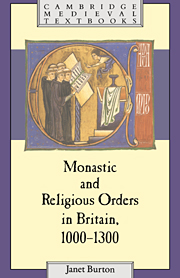Book contents
- Frontmatter
- Contents
- List of illustrations
- Preface
- 1 Before the Normans
- 2 The coming of the Normans
- 3 The regular canons
- 4 The new monastic orders of the twelfth century
- 5 Women and the religious life
- 6 The mendicant orders
- 7 The physical setting: monastic buildings and the monastic plan
- 8 Inside a religious house: daily life and the chain of command
- 9 Learning and literary activities
- 10 Religious houses and the wider community: founders, patrons and benefactors
- 11 The monastic economy
- 12 On the brink of change
- Glossary
- Notes
- Select bibliography
- Index
- Cambridge Medieval Textbooks
6 - The mendicant orders
Published online by Cambridge University Press: 05 June 2012
- Frontmatter
- Contents
- List of illustrations
- Preface
- 1 Before the Normans
- 2 The coming of the Normans
- 3 The regular canons
- 4 The new monastic orders of the twelfth century
- 5 Women and the religious life
- 6 The mendicant orders
- 7 The physical setting: monastic buildings and the monastic plan
- 8 Inside a religious house: daily life and the chain of command
- 9 Learning and literary activities
- 10 Religious houses and the wider community: founders, patrons and benefactors
- 11 The monastic economy
- 12 On the brink of change
- Glossary
- Notes
- Select bibliography
- Index
- Cambridge Medieval Textbooks
Summary
In the third decade of the thirteenth century Britain was engulfed by a new and radical religious movement which challenged all accepted notions of the monastic life. The friars were not, like Benedict's monks, to live their lives within the cloister; nor were they to support themselves by ownership of property. They were itinerant and they were mendicant, that is, they wandered from place to place and were allowed to beg for their livelihood. They were to live in poverty, in imitation of the apostles. Four main mendicant orders, with diverse geographical and ideological origins, became influential in Britain: the Franciscans (Friars Minor), the Dominicans (Friars Preacher, or Black Friars), the Augustinian (Austin) Friars, and the Carmelites (the White Friars). A little needs to be said about how these orders emerged and developed, for it is only in the context of their purpose and aspirations that their migration into Britain can be appreciated.
The intention and message of St Francis was at one and the same time simple and powerful. The son of a wealthy merchant of Assisi, Francis underwent a religious conversion, and in a dramatic gesture renounced both family and possessions. His purpose was to embrace absolute poverty, own nothing, and to live as Christ himself had done, teaching and preaching by word and example. Francis was not the only individual to give voice to such an intention, or the only one to gather disciples around him.
- Type
- Chapter
- Information
- Monastic and Religious Orders in Britain, 1000–1300 , pp. 109 - 130Publisher: Cambridge University PressPrint publication year: 1994

